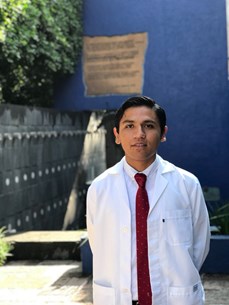Meeting
2024 ASCO Gastrointestinal Cancers Symposium

Instituto Nacional de Ciencias Medicas y Nutrición Salvador Zubirán, Mexico City, DF, Mexico
Jorge Humberto Hernandez-Felix , Mónica I. Isabel Meneses-Medina , Marco Antonio Jiménez Meza , Emilio Conde Flores Jr., Vanessa Rosas Camargo , Fidel David David Huitzil Melendez
Background: Gastric cancer is the fifth leading cause of cancer-related deaths in Mexico. Diagnosis is often made at advanced stages, resulting in a poor prognosis. The delay from the onset of the first symptom to diagnosis and treatment could influence the poor prognosis of gastric cancer patients (pts) in our country. In Mexico, information on this topic is limited. We aim to investigate the time delay between the onset of symptoms, histological diagnosis, and initiation of oncological treatment in pts with gastric adenocarcinoma. Methods: We conducted a retrospective review of the clinical records at our institution of all pts with confirmed histological diagnosis of gastric adenocarcinoma (GC) treated between Jan 2005 and Dec 2017. Overall Survival (OS) was estimated using the Kaplan-Meier method. Groups were compared using Log-Rank test. Results: We included 270 pts with confirmed histopathological diagnosis of GC, 53.3% (n=144) women, median age 58 years (IQR 25-75); 44% (n=121) reported family history of cancer, 39.6% (n=107) smoking, H. pylori infection was documented in 22% (n=61). Symptoms before diagnosis were present in 98.5% (n=266) of pts, most common were: weight loss 77.4% (n=209), fatigue 51.9% (n=140), early satiety 51.1% (n=138), nausea 48.9% (n=132), vomiting 48.1% (n=130), dysphagia 21.5% (n=58), and gastrointestinal bleeding 37.8% (n=102). The most common method for histological diagnosis was endoscopy with biopsy in 86.7% (n=234). The median time between the onset of symptoms and histopathological diagnosis was 4.21 (IQR 2.25–8.48) months (m), between the onset of symptoms and the initiation of oncological treatment 5.28 (IQR 2.86–9.52) m, and between histopathological diagnosis and oncological treatment 0.60 (IQR 0.13–1.21) m. 72.6% (n=196) of cases were stage IV, 14.1% (n=38) stage III, 8.1% (n=22) stage II, 4.8% (n=13) and stage 0 or I. The median OS for the entire cohort was 7.2 m, 3.7 m for stage IV, 17.3 m for stage III, and 84 m for stage I. Median OS for stage II was not reached, and it was 58% at 5 years. Symptoms associated with worse or better survival are shown in table. Conclusions: Reducing delays in histopathological diagnosis from symptom onset could lead to earlier detection and curative treatments. Identifying alarm signs and appropriate patient navigation would enable earlier diagnosis and early treatment.
| Symptoms (%) | Median Survival (months) | p |
|---|---|---|
| Anorexia | ||
| Yes (47) No (53) | 4.7 (2.3-7.04) 8.4 (6.5-10.3) | <0.001 |
| Early satiety | ||
| Yes (52) No (48) | 6.03 (2.9-9.07) 7.5 (5.6-9.4) | <0.001 |
| Abdominal pain | ||
| Yes (72) No (28) | 5.4 (3.3-7.4) 9.8 (7.8-11.7) | 0.02 |
| Ascites | ||
| Yes (20) No (80) | 0.9 (0.2-1.6) 4.2 (3.4-5.05) | 0.03 |
| Palpable mass | ||
| Yes (15) No (85) | 1.5 (0-5.4) 7.5 (5.5-9.5) | 0.01 |
| Gastrointestinal bleeding Yes (38) No (62) | 8.1 (4.2-11.9) 6.1 (3.8-8.4) | <0.001 |
Disclaimer
This material on this page is ©2024 American Society of Clinical Oncology, all rights reserved. Licensing available upon request. For more information, please contact licensing@asco.org
2024 ASCO Gastrointestinal Cancers Symposium
Poster Session
Poster Session A: Cancers of the Esophagus and Stomach and Other Gastrointestinal Cancers
Esophageal and Gastric Cancer,Other GI Cancer
Patient-Reported Outcomes and Real-World Evidence
J Clin Oncol 42, 2024 (suppl 3; abstr 291)
10.1200/JCO.2024.42.3_suppl.291
291
D11
Abstract Disclosures
2023 ASCO Annual Meeting
First Author: JEONGSEOK JEON
2023 ASCO Annual Meeting
First Author: Bolin Song
2024 ASCO Gastrointestinal Cancers Symposium
First Author: Jihong Bae
2024 ASCO Gastrointestinal Cancers Symposium
First Author: Takako Ikegami